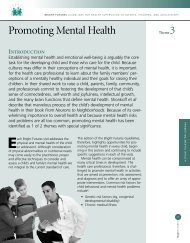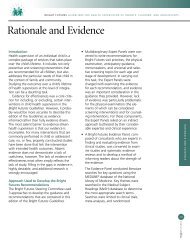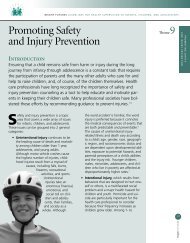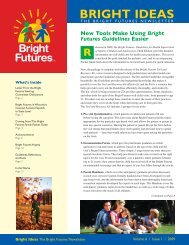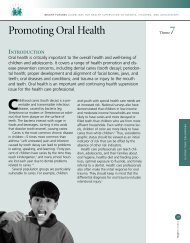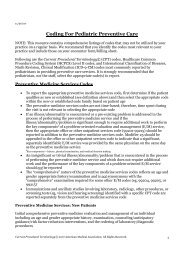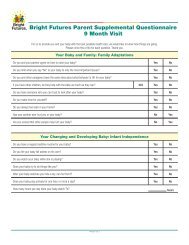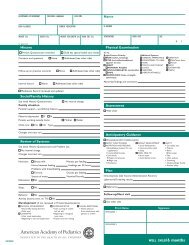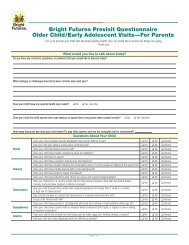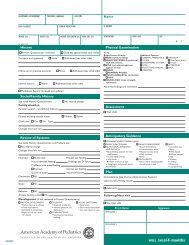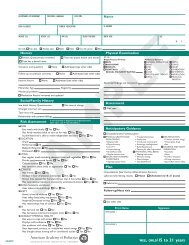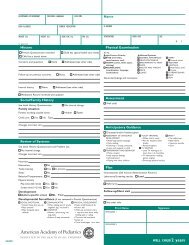POCKET GUIDE - Bright Futures - American Academy of Pediatrics
POCKET GUIDE - Bright Futures - American Academy of Pediatrics
POCKET GUIDE - Bright Futures - American Academy of Pediatrics
You also want an ePaper? Increase the reach of your titles
YUMPU automatically turns print PDFs into web optimized ePapers that Google loves.
Middle Childhood<br />
40<br />
<strong>Bright</strong> FUTURES<br />
for the older Child<br />
■ how do you feel about your weight?<br />
■ how much would you like to weigh?<br />
■ Are you trying to change your weight? if so, how?<br />
for the Parent<br />
■ how do you feel about your child’s weight?<br />
physical Activity<br />
for the Child<br />
■ What do you do to be physically active? how <strong>of</strong>ten?<br />
■ how much time do you spend being active in a week?<br />
■ how much time do you spend each day watching television<br />
and playing computer or video games?<br />
■ What do you think you can do to be more active?<br />
for the Parent<br />
■ What types <strong>of</strong> physical activity does your child engage in?<br />
how <strong>of</strong>ten?<br />
■ how much time does your child spend each day watching<br />
television or playing computer or video games?<br />
■ Does your child have a television in his bedroom?<br />
Screening and Assessment<br />
growth and physical Development<br />
■ Measure the child’s height and weight, and plot them on a<br />
standard growth chart. Deviation from expected growth<br />
patterns should be evaluated. This may be normal or may<br />
indicate a nutrition problem.<br />
■ Determine the child’s nutrition status and overall health<br />
using body mass index (BMi). Calculate the child’s BMi<br />
by dividing weight by square <strong>of</strong> height (kg/m 2 ), or use a<br />
BMi wheel or calculator. Plot the child’s BMi and age on<br />
a BMi-for-age growth chart to determine BMi percentile.<br />
■ evaluate the appearance <strong>of</strong> the child’s skin, hair, teeth,<br />
gums, tongue, and eyes.<br />
■ obtain the child’s blood pressure.<br />
■ Assess the child’s risk for familial hyperlipidemia.<br />
stunting<br />
■ if height-for-age is below the third percentile, evaluate<br />
to determine whether growth is stunted and whether the<br />
child may benefit from improved nutrition or treatment<br />
<strong>of</strong> other underlying problems.<br />
■ Low height-for-age is usually the result <strong>of</strong> genetics, not<br />
the result <strong>of</strong> stunted growth.



